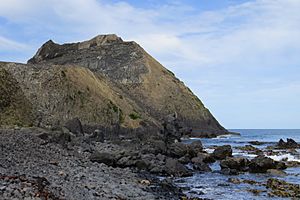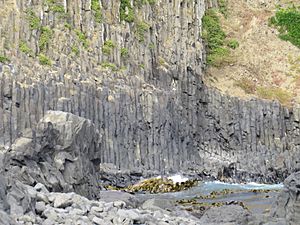Blackhead (New Zealand) facts for kids
Blackhead is a cool spot on the coast of Otago, New Zealand. It's like a rocky finger sticking out into the ocean, about 10 kilometers (6 miles) southwest of Dunedin city. This rocky point goes out about 500 meters (1,640 feet) into the sea and rises a bit over 100 meters (328 feet) high. The Māori people have special names for Blackhead, like Te Wai o Tinarau (which means "the waters of Tinarau") and Makereatu (meaning "to leave a seed").
The coast to the east of Blackhead is rugged and steep, with lots of tall cliffs. A famous tourist spot called Tunnel Beach is in this area, about 3 kilometers (1.8 miles) from Blackhead. To the west, the coast is flatter with nice beaches. The small town of Waldronville is here, about 1,500 meters (almost a mile) from Blackhead, near where the Kaikorai Stream meets the sea. Blackhead Beach, which is right under the quarry, is a favorite place for local surfers.
Blackhead was formed a very long time ago, about 10 million years ago! It was part of the Dunedin Volcano, which is now gone, but its remains form the hills around Otago Harbour. One of the coolest things about Blackhead are its amazing basalt columns. These are like giant, natural pillars made of rock, similar to ones you can see at Second Beach a few kilometers to the east. You can easily see some of these columns from Waldronville and Blackhead Beaches. However, some of the most spectacular rock formations, like the "Roman Baths" and "The Docks," are harder and more dangerous to reach because they are on the ocean side of the rocks. Another hard-to-reach spot is Caversham Cavern, which is one of the biggest sea caves on the Otago coast.
What is the Blackhead Quarry?
Blackhead is also home to an active rock quarry called Blackhead Quarry. It has been working since the 1950s and is currently run by Palmer & Sons and Fulton Hogan. Each year, they produce about 120,000 tonnes of crushed rock, mostly basalt. They also find small amounts of other minerals like natrolite, phillipsite, calcite, olivine, chabazite, and thomsonite. This crushed rock is mainly used to build and repair roads.
The amazing basalt columns are not dug up or removed by the quarry. They are protected by a special legal agreement called a covenant, which means they cannot be harmed. In the 1980s, Fulton Hogan wanted to dig out the center of Blackhead to create a boat harbor. But a group of people who cared about the area, called "The Friends of Blackhead," formed specifically to stop this plan, and they succeeded!




